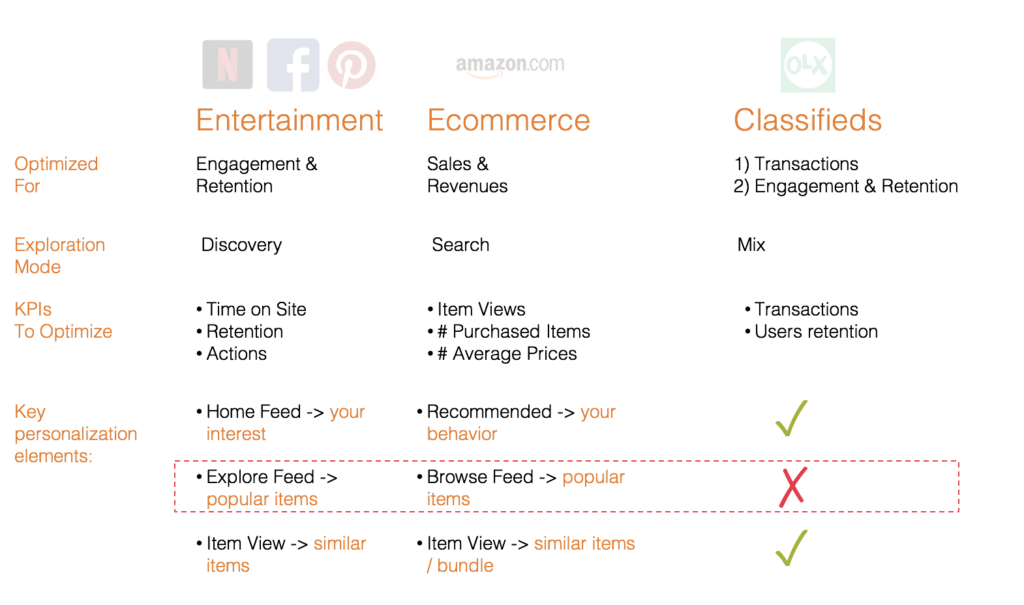Personalization in the Online classifieds industry – OLX path to a customized experience

The online classifieds industry started almost 30 years ago, when companies began to move the newspaper classifieds into a web-based platform. As time went by, more features were added to lower the efforts in achieving a transaction.
OLX was founded by Fabrice Ginda and Alec Oxenford (HBS 97, later founded Letgo as well) in 2006 with the vision of becoming the classifieds leader for the emerging world. At the same time, the mobile industry was also emerging in these markets and OLX quickly became a leader in that segment, growing a very strong position in the app market across 41 markets.
As the industry started to grow even more (especially in Apps), competition grew and users began to demand a more customized experience, while at the same time more information was available to target them. Two possible strategies where adopted by the different players in the industry: vertical integration or delivering an extraordinary personalized experience. OLX, having been a pioneer into the native apps’ world wanted to maintain its position at the edge of innovation, and decided to gor for the latter using AI and machine learning. As Oxenford says: “technology helps us personalize the user experience and moderate our marketplace, which is a huge advantage at our scale”. [1]
Now the question was how to effectively apply machine learning to maximize the impact into the classifieds business:
In order to answer this question, some context from the classifieds business is needed: There are two main type of customers, sellers and buyers. For the latter, AI could help to personalize/rank each customer’s feed (list of ads the user sees) and ad recommendations based on his/her preferences. Many companies from the entertainment industry (Netflix, Facebook, etc) and the e-commerce world (amazon, others) were already using AI and machine learning to show more relevant content to the users (exhibit 1), but were their algorithms applicable to the classifieds industry? (exhibit 2). For the seller, the main goal was to minimize the effort towards posting a sellable ad. Here, AI use would be through image recognition (suggest a title, description, price, attributes and categories based on the user’s uploaded image). A third option for AI that would benefit both the seller and the buyer was text recognition through the chat, where both users connected to complete the transaction. Last, AI could also boost monetization by tailoring the ads offered to each customer, but the short-term focus of the company was to grow its user base.
As stated by the Head of personalization of the BA office: “OLX decided to go for all the growth options of AI at the same time. We built a team in Berlin to deliver an image recognition service, as none of the ones available in the market suited our needs. A team in India was focusing in text recognition to offer pre-defined messages for users and determining when an item was sold. Last, BA office (Buenos Aires, Argentina) was in charge of feed personalization and recommendations. This was the big challenge…”
To address this challenge OLX had to change its organizational structure, with the BI and data scientists’ teams now embedded into cross-functional teams to gain speed and shorter trial-error loops. It also needed to completely change the way data was stored and organized.
The variables that would affect the way items were rank for each user can be grouped in the following categories: user data (previous activity in the platform: interest (buyer) & quality (both), demographics and social media) and item data (quality, freshness, popularity). The first one was more straight-forward, and it was expected to deliver results across markets in the following year, with over 200% improvements in target KPIs during AB test experiments phase (as stated by the leader of the project). But in order for machine learning to be a game changer in the way OLX showed content to the users, items also needed to be ranked. After initial testing, the team found a big issue: while most companies rely heavily in popular items and connection between items by the interaction of users with them through long periods of time, at OLX each item was unique, and the moment after it became popular it was sold and therefore not available.
While on the seller side image recognition was delivering good results in terms of improving item quality and flow conversion, the exponential growth from AI would not come until the buyer side cracked the item data challenge.
To overcome the challenge around items being unique, OLX could build clusters with all previous ads posted in the platform and their respective performance, and a second ML algorithm that predicted the popularity of an ad the moment it enters the platform, clustering and comparing it to previous posted ads in the platform.
Looking forward, some big questions remain open. Will OLX be able to maintain its app market dominance through personalization? Even if OLX succeeds in doing so, will delivering a superior personalized experience compensate for the lack of vertical integration or it will need to address that as well?
(Word count: 844)
[1] Alec Oxenford interview, “How AI helps reinvent the secondhand marketplace” https://www.pymnts.com/news/artificial-intelligence/2018/letgo-naspers-funding-secondhand-marketplace-used-goods-ecommerce/
Exhibit 1
Source: Internal data
Exhibit 2
Source: Internal data





This is a very interesting read on leveraging machine learning, mostly image and text recognition and classification, to drive the success of the business from both supply (seller) and demand (consumer) side. I also appreciate the thoughts on exploring the predicting algorithm to driver the ML to the next level. In addition, the author emphasized the rank (priority) of different meta datasets being used, which is often neglected in a lot of business cases. Lastly, the author took the step back and really question the level of effectiveness of personalization for this particular business model, which I found it very thoughtful!